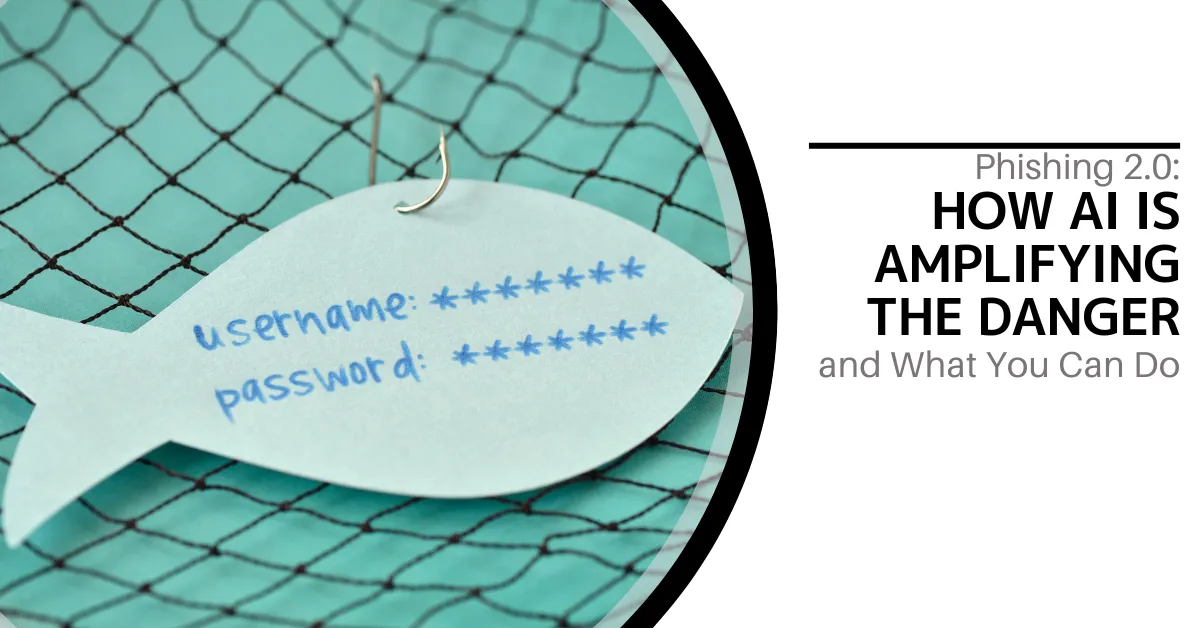
EnTech IT Solutions Blogs
Helpful Blogs Posts to keep you in the know!

Phishing 2.0: How AI is Making Cyber Threats More Dangerous Than Ever
Phishing 2.0: How AI is Making Cyber Threats More Dangerous Than Ever
Phishing has evolved, and it’s more dangerous than ever. With AI at the helm, traditional phishing has transformed into an intelligent and elusive threat. Welcome to Phishing 2.0—where attacks are smarter, more convincing, and incredibly difficult to spot. Understanding this new wave of cyberattacks is crucial to your digital safety.
A recent study has revealed a staggering 60% increase in AI-driven phishing attacks. This statistic serves as a wake-up call, underscoring the growing menace of phishing. Here’s a deep dive into how AI is amplifying phishing tactics and the measures you can take to protect yourself.
The Evolution of Phishing
Phishing wasn’t always as sophisticated as it is today. Initially, attackers cast wide nets with mass emails, hoping a few unsuspecting victims would bite. These emails were often riddled with spelling mistakes and obvious falsehoods, making them relatively easy to identify and avoid.
However, the landscape has changed drastically. Today, attackers harness the power of AI to fine-tune their tactics. AI enables them to craft messages that are not only convincing but also specifically tailored to individual targets, making phishing attempts more effective and harder to detect.
How AI Enhances Phishing
Creating Realistic Messages
AI’s ability to analyze vast amounts of data allows it to generate phishing messages that closely mimic legitimate communications. By studying how people write and speak, AI can produce emails that sound authentic and credible, making it much more difficult for recipients to distinguish between real and fake messages.
Alt Text: "AI-generated realistic phishing email on a computer screen."
Personalized Attacks
Leveraging information gathered from social media and other online sources, AI can create highly personalized phishing messages. These emails might mention your job title, recent activities, or hobbies—details that make the message appear genuine and increase the likelihood of you falling for the scam.
Alt Text: "AI personalizing phishing emails with detailed user information."
Spear Phishing
Spear phishing is a more targeted form of phishing that focuses on specific individuals or organizations. AI amplifies the threat by enabling attackers to conduct in-depth research on their targets, allowing them to craft messages that are almost indistinguishable from legitimate communications.
Alt Text: "Targeted spear phishing attack using AI."
Automated Phishing
AI can automate many aspects of phishing, sending out thousands of emails in a short period and even adapting messages based on recipient responses. For instance, if you click on a link but don’t provide the requested information, AI can automatically send a follow-up email to try again, increasing the chances of a successful attack.
Alt Text: "AI automating the process of sending phishing emails."
Deepfake Technology
Deepfake technology adds a terrifying new dimension to phishing. AI can create convincing fake videos or audio recordings, such as a video of a CEO requesting sensitive information. This level of deception can be incredibly convincing, making it easier for attackers to manipulate victims.
Alt Text: "Deepfake video used in a phishing scam."
The Impact of AI-Enhanced Phishing
Increased Success Rates
With AI’s help, phishing attacks have become more successful. As more people fall for these sophisticated scams, the frequency of data breaches rises, leading to significant financial losses for businesses and severe consequences for individuals.
Harder to Detect
Traditional phishing detection methods struggle to keep up with AI-enhanced attacks. These emails can slip past spam filters and appear legitimate to even the most cautious employees, making it easier for cybercriminals to achieve their goals.
Greater Damage
AI-enhanced phishing has the potential to cause more significant harm. With personalized attacks leading to major data breaches, attackers can gain access to highly sensitive information or disrupt critical operations, resulting in severe consequences.
How to Protect Yourself
Be Skeptical
Always approach unsolicited messages with skepticism, even if they appear to come from a trusted source. Verify the sender’s identity before clicking on links or downloading attachments.
Check for Red Flags
Watch out for common red flags in emails, such as generic greetings, urgent language, or requests for sensitive information. If an email seems too good to be true, it probably is.
Use Multi-Factor Authentication (MFA)
MFA provides an additional layer of security, making it more challenging for attackers to gain access to your accounts, even if they have your password.
Educate Yourself and Others
Staying informed about phishing tactics and educating others is crucial. Regular training can help you and your team recognize and avoid falling victim to these sophisticated scams.
Verify Requests for Sensitive Information
Never provide sensitive information via email. If you receive such a request, verify it through a separate communication channel, like a phone call to the person using a known, trusted number.
Use Advanced Security Tools
Investing in advanced security tools can help detect and block phishing attempts. Keep your software up to date to ensure maximum protection.
Report Phishing Attempts
If you receive a phishing attempt, report it to your IT team or email provider. This helps improve security measures and protect others from similar attacks.
Enable Email Authentication Protocols
Implement email authentication protocols like SPF, DKIM, and DMARC to safeguard against email spoofing. Ensuring these are enabled for your domain adds an extra layer of protection.
Regular Security Audits
Conduct regular security audits to identify and address vulnerabilities in your systems, preventing potential phishing attacks.
Need Help with Safeguards Against Phishing 2.0?
Phishing 2.0, powered by AI, is a formidable threat. These attacks are more convincing and harder to detect than ever before. If it’s been a while since your last email security review, it’s time to act.
Give us a call today to start a conversation!
📞 720-704-3318
📧 Start a Conversation today!
🌐 EnTech IT Blog - Get more helpful IT Tips

Connect
Call Or Text:






